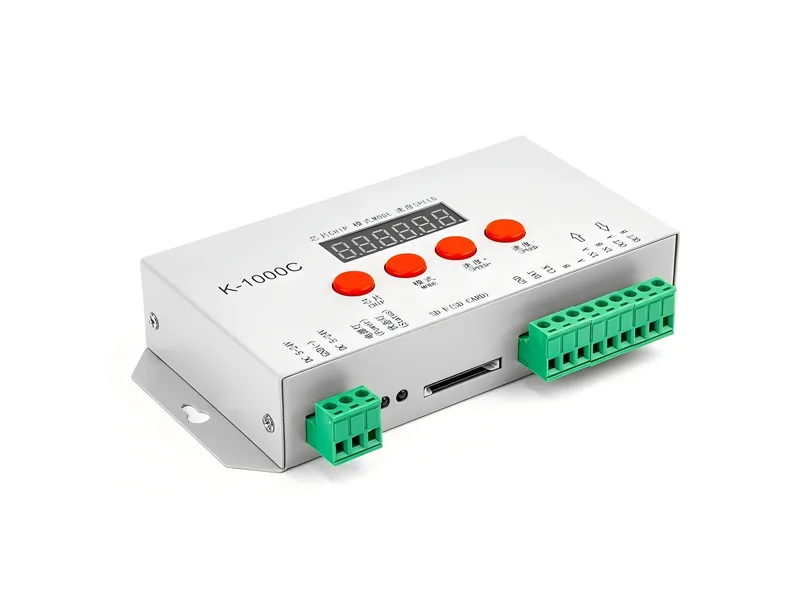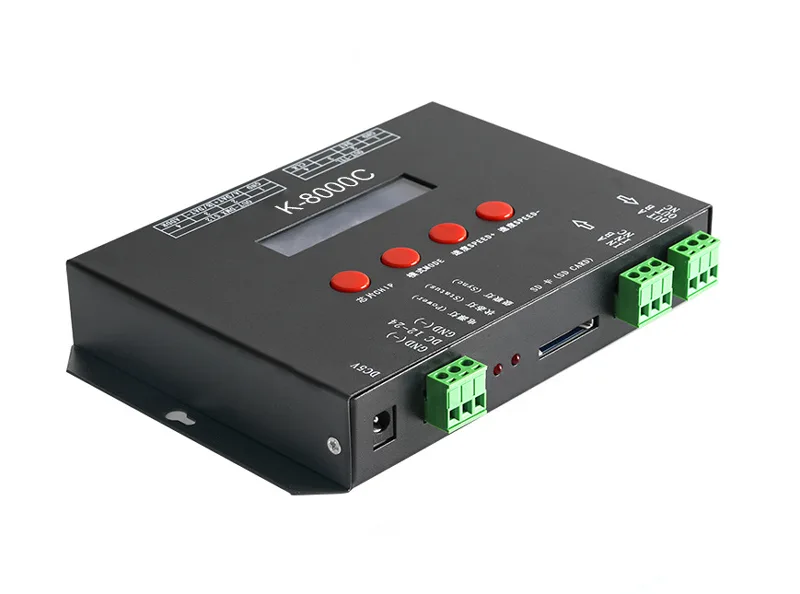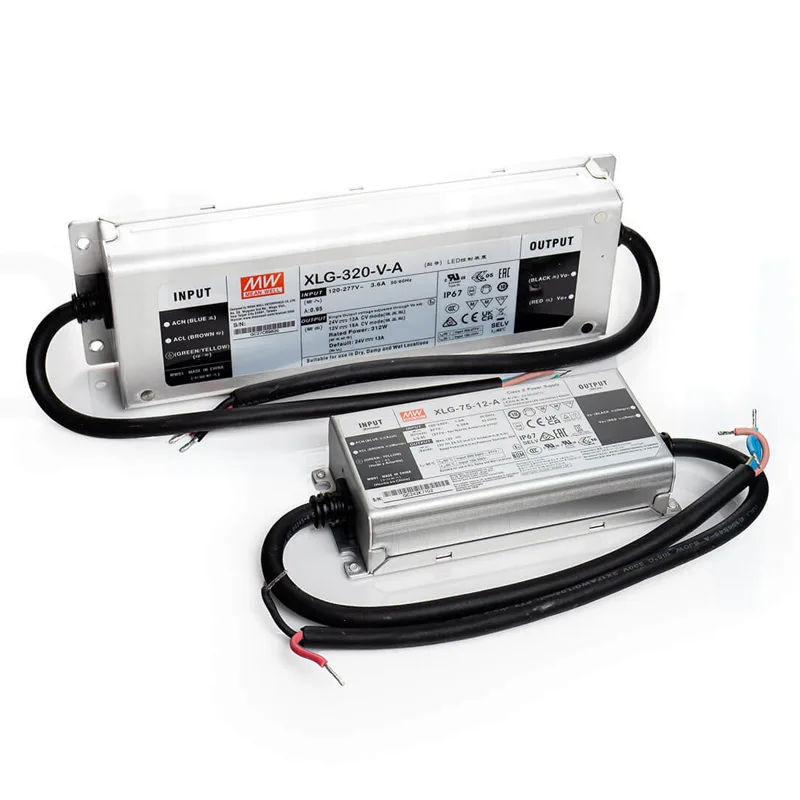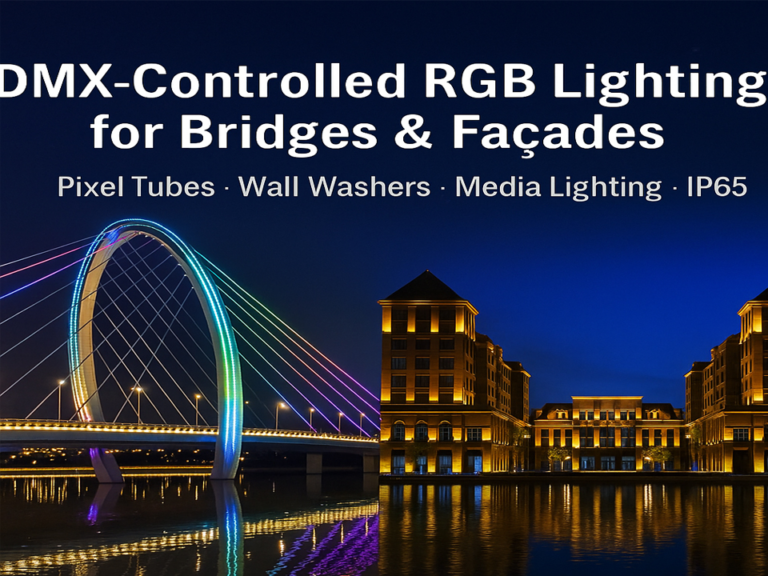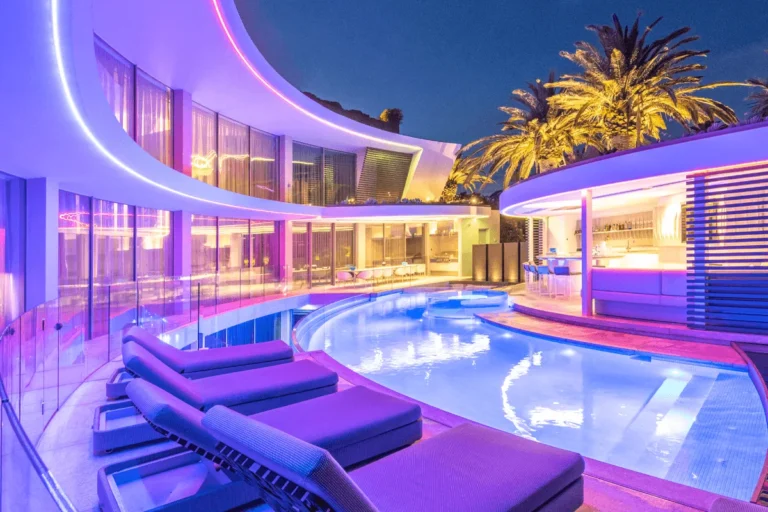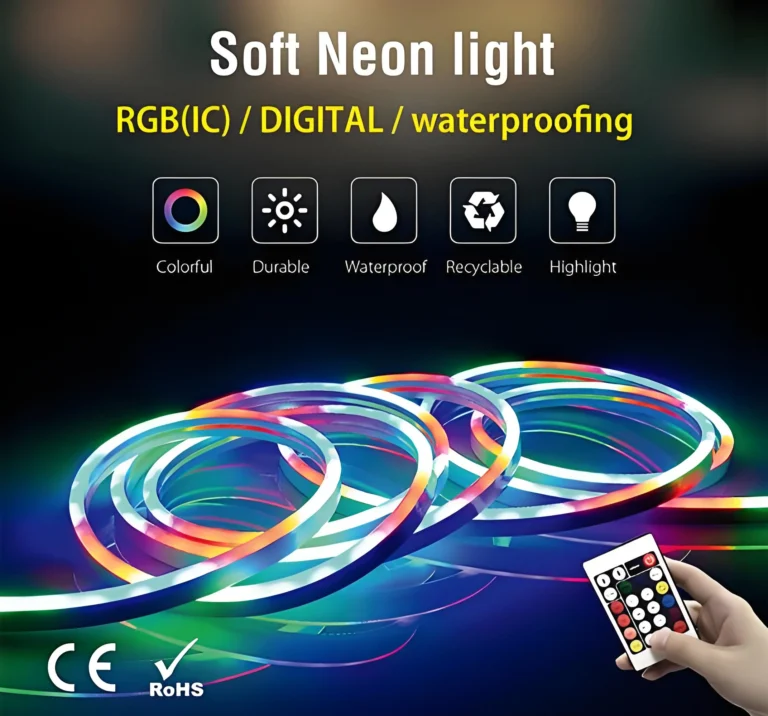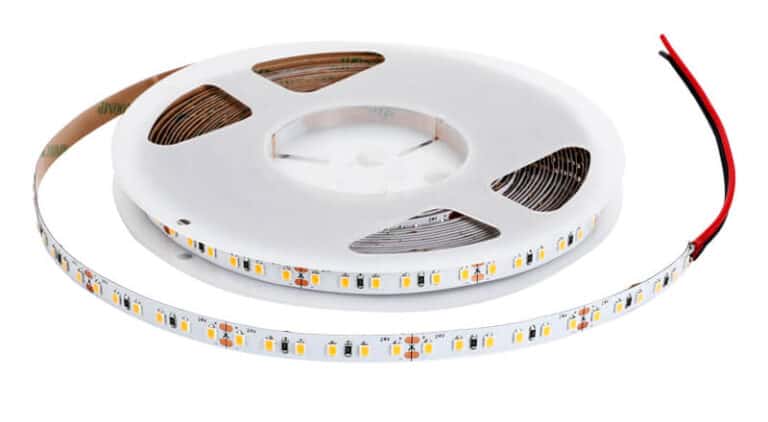新世代のLED建築照明が登場しつつある:LEDネオンフレックスは、形状の整った建物の外壁に完璧にフィットし、従来のネオンよりも消費電力が85%少なく、DMX512インテリジェント制御システムにより、1つの建物で256万色の組み合わせを実現できる。
上海センタータワーの螺旋状の光の効果や広州タワーのピクセル化された光のショーは、デジタル照明の無限の可能性を証明している。深センの平安ビルの照明システムは、PM2.5のデータにリアルタイムで反応し、都市の空気の質を光と影で可視化することができる。インテリジェント照明は、ビルのファサードをデジタル・キャンバスに変え、祝祭日や公共サービス・キャンペーンなどのシーンをシームレスに切り替えるようプログラムできる。ミラノの「垂直の森」の照明は、樹木の光合成のリズムさえも模倣しており、建物を生命体のようにしている。
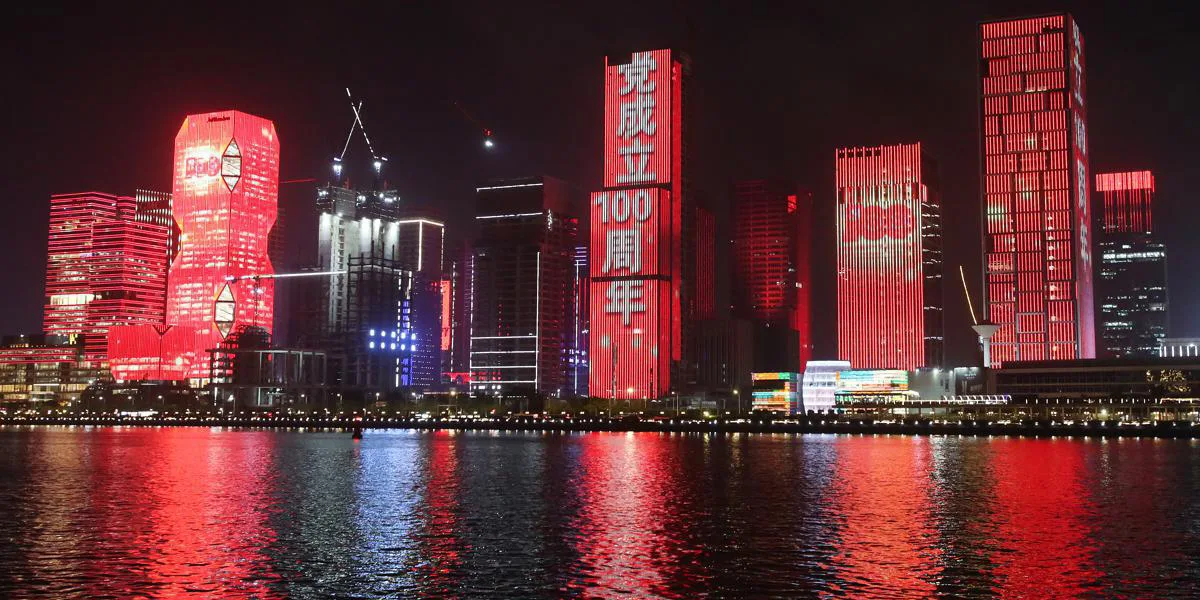
建築照明デザインにおいて、DMX制御のLEDネオンFlexは、その優れた柔軟性とダイナミックな表現力で、空間美学を再構築しています。DMX512プロトコルにより、デザイナーは各ストリップの明るさ、色、ダイナミクスを正確に調整することができ、緩やかな呼吸から複雑なリズムまで、無限の創造性を可能にします。このテクニカルガイドでは、DMX照明システムのアーキテクチャ、設計ポイント、従来機器の製品選択について分析する。ぜひご一読いただき、プロジェクトの迅速な実現にお役立てください。
インテリジェント照明におけるDMX512プロトコルの利点
DMX512プロトコルは、512の独立したチャンネルによるライト・バイ・ライト制御を実現し、色、明るさ、動的効果などの多次元パラメーターを正確に駆動することができ、舞台やビルのファサードなどのシーンにおける複雑な光の効果に対する厳しい要求を満たすことができます。
そのミリ秒の応答速度は、大規模なランプやランタンの同期動作を保証し、ダイナミックなライトチェイスや音楽連動などのリアルタイム・インタラクティブ・アプリケーションに特に適しています。マスター・スレーブ・アーキテクチャと差動信号方式を採用し、最大32台の直列デバイスと数千のノードをサポートし、優れたシステム拡張性を提供します。
標準化されたインターフェースと強力な互換性により、調光器、コントローラー、各種インテリジェントランプへのシームレスなアクセスを可能にし、RS485物理層のアンチジャミング特性と組み合わせることで、プロジェクトの複雑な電磁環境においても安定した伝送を維持します。
このような技術的特性により、DMXは、大規模なパフォーマンス、テーマ景観、ビルのファサード、その他のプロフェッショナルな照明の分野で好まれる制御ソリューションとなっています。
なぜLEDネオンフレックスを建築照明に使うのか?

を使用する。 建築照明用LEDフレキシブルネオンストリップ には複数の利点がある。まず、超柔軟性により、複雑な曲面や形状の構造物にもフィットし、建物の外形、ファサードの装飾、ドームの周囲など独創的なデザインを容易に実現し、照明芸術に強い表現力を与えることができる。
ネオンライト・ストリップはモジュール設計を採用しており、さまざまなサイズの設置シーンに合わせて自由にカットや接続が可能で、施工の難易度を大幅に下げることができる。
第二に、LED光源は高い発光効率と低エネルギー消費特性を持ち、インテリジェント調光システムにより、従来の照明に比べてエネルギー効率が50%以上向上し、低発熱で建物の熱負荷を低減する。
第三に、RGBフルカラーライトミキシングとダイナミックプログラミングをサポートし、DMXまたはワイヤレスプロトコルを介して、カラーグラデーション、ランニングライト、音楽連動などの効果を実現し、建築夜景のインタラクティブ性と技術センスを高める。
また、フレキシブルストリップの外層はシリコーンまたはエポキシ樹脂で封止されており、防水等級はIP67以上、耐候性が強く、屋外の温度差、雨、紫外線環境にも適応し、寿命は最大5万時間で、メンテナンスコストを大幅に削減できる。また、低電圧電源(12/24V)特性により、電気安全性も向上し、現代建築照明プロジェクトに最適なソリューションです。
DMX512システムとは何ですか?
DMX512(Digital Multiplex 512)は、舞台照明、建築照明などの分野で広く使用されているデジタル制御プロトコル規格です。デジタル化された信号により、器具の精密な制御を実現します。その基本原理はシリアル通信による制御コマンドの伝送で、各DMX信号リンクはマスターコントローラー(調光コンソールなど)と複数のスレーブ機器(フィクスチャー、調光器など)で構成されています。このシステムはRS-485物理層規格に基づき、差動信号伝送技術を採用しており、強力なアンチジャミング能力を持ち、最大伝送距離は1200メートル(リピータ増設が必要)です。
各DMXデータフレームは512個の独立したコントロールチャンネルを含みます;各チャンネルは8ビットデータ(値範囲0-255)に対応し、ランプの明るさ、色、モーショントラック、その他のパラメーターを調整することができます。例えば、RGB LED器具は通常3チャンネル(赤、緑、青に各1チャンネル)を占有し、アドレス・エンコーダで開始チャンネル番号を設定した後、対応するコマンドを受信できます。コントローラは、最大250kbpsの速度でデータパケットを周期的に送信し、1秒間に約44回のリフレッシュを行い、照明変更のリアルタイム同期を確保します。システムは連鎖式シリアル構造をサポートし、1つのラインで最大32台のデバイスを制御でき、スプリッターを介して数千ノードまで拡張できるため、大規模な照明プロジェクトのニーズに対応できる。
DMX512システムの構成には、主に以下の部品が含まれます:
DMXコンソール制御信号を送信する主装置(照明コンソールやソフトウェアなど)。
DMXレシーバーデコード・モジュール:器具やその他の機器に搭載され、コマンドを受信して実行する。
DMXケーブル:専用シールドツイストペアケーブル、5ピンまたは3ピンXLRコネクター付き。
終端抵抗:信号の反射干渉を防ぐため、信号チェーンの最後に抵抗(通常120Ω)を取り付ける。
DMX512ネオンテープの特徴は?
- DMXピクセルネオンストリップは、独立して制御される複数のLEDビーズ(ピクセル)で構成されています。各ピクセルは個別に色(RGB/RGBWなど)と輝度を調整でき、ダイナミックなパターンやグラデーション効果を形成できます。各LEDを個別にプログラムすることで、繊細なアニメーション効果(流水、点滅、フェードなど)を得ることができます。
- 従来のネオンライトに比べ、エネルギー効率が高く、耐久性に優れ、プログラミング制御をサポートしている。
- フレキシブルな素材(シリコン、PVCなど)でラッピングされたLEDネオンストリップは、複雑な形状(曲面、湾曲した構造物など)の設置環境に適応するため、自由に曲げたりカットしたりすることができる。
- 長距離伝送(最大1200メートル)、高い互換性、同時に複数のデバイスを制御することができます。
- 文字、パターン、動画に適した高解像度表示に対応。
- DMXコントローラーを通してコマンドを送信し、ムービングヘッドライトやレーザーライトなど、他のステージ照明機器と同期させ、一体感のある演出が可能。
- 大規模なインスタレーション(ビルのファサードや大型ステージなど)のニーズに対応するマルチユニバース拡張に対応。
- 防水等級が高く、過酷な屋外環境にも耐える。通常IP65またはIP67で、屋内および屋外での使用に適している。
- カット可能なデザイン:必要に応じて長さを調整でき、設置の複雑さを軽減。
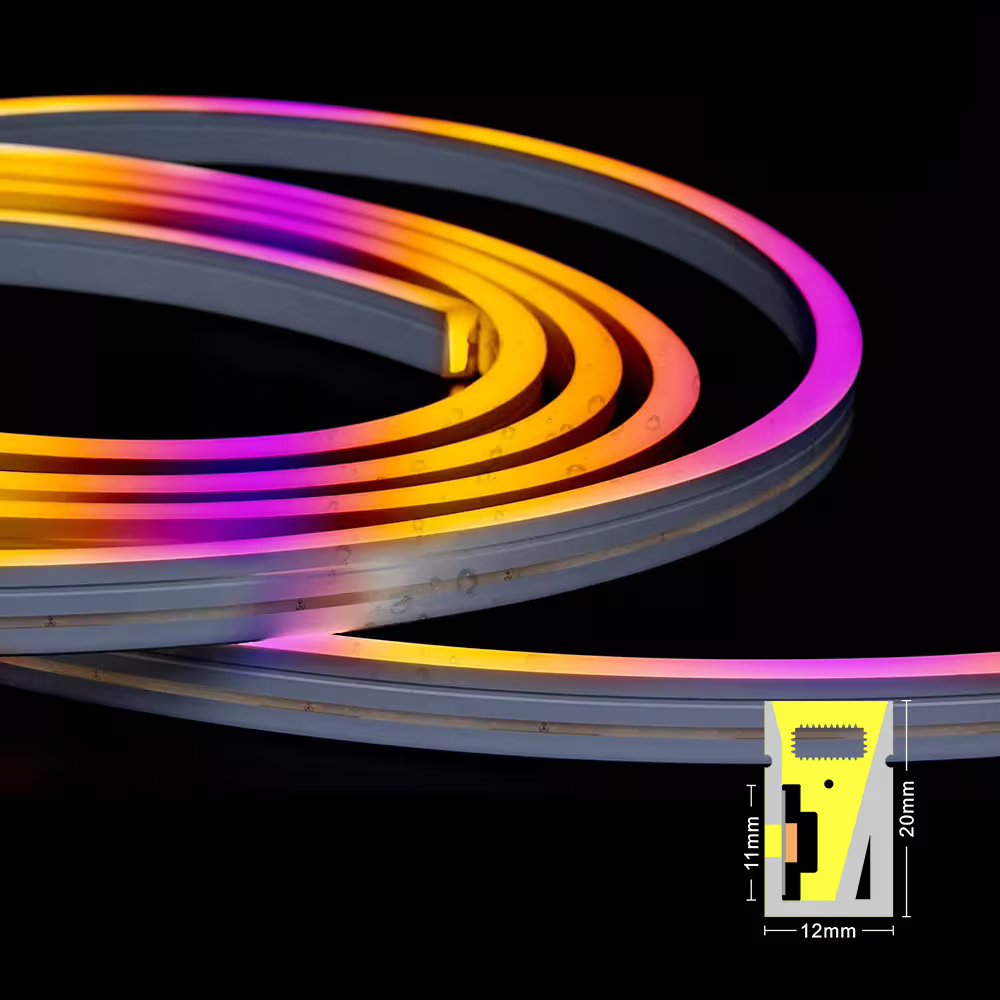
建築、壁の艶出し器及び正面の照明のための側面のくねりS1220のシリコーンの住所指定可能なLEDのネオンストリップ
入力電圧DC24V
ワット:12W/m@RGB、19W/m@RGBW
LED QTY: SMD5050 60LEDs/m
色温度:RGB/RGBW(2700K-6500K)
信号タイプSPI/DMX512
IP等級: IP65/IP67
ケーブル・エントリーフロント
最小曲げ直径: 100mm
カット可能な長さ:100mm
長さ:5メートル/ロール
DMX512はどのようにLEDネオン・ストリップを制御するのですか?
DMX512コントローラは、デジタル信号(RS-485規格に準拠)を介してLEDネオンストリップシステムにコマンドを送信します。信号はデコーダによって解析され、プリセットアドレスに従って各LEDピクセルのRGBチャンネルデータを一致させ、独立して明るさ(0〜255レベル)と色を調整します。プリセットシーンまたはリアルタイム制御のプログラミングにより、ダイナミックグラデーション、同期点滅など、ステージ、ビル、その他のシーンに適用する効果を実現し、複数のデバイスが一緒に動作し、干渉防止を確実にするために、具体的な制御接続は、次の回路図を参照してください。
DMX512システム接続回路図:
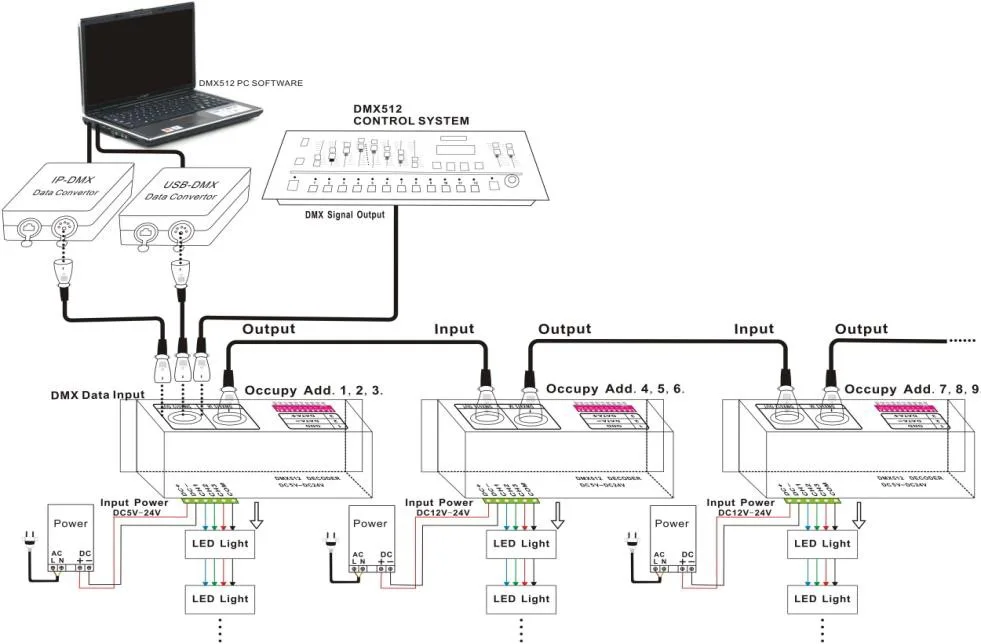
DMX512制御機器の選択
I.DMX512マスター
DMX512マスターは、国際標準DMX512/1990の信号をDMX512デコーダーに出力し、単色、二色CCT、RGB、RGBW、RGB+CCTのLED照明を調光制御します。最も一般的に使用されているのは、以下の2つです:
1.DMX512タッチパネルコントローラー:DMX512出力をサポートし、調光、色温度調整、RGB/RGBW制御機能を内蔵、ゾーン管理機能(最大4ゾーン)、複数のダイナミックモード(グラデーション、ジャンプなど)を統合。86タイプの設置デザインは、商業施設や家庭での使用に適しています。
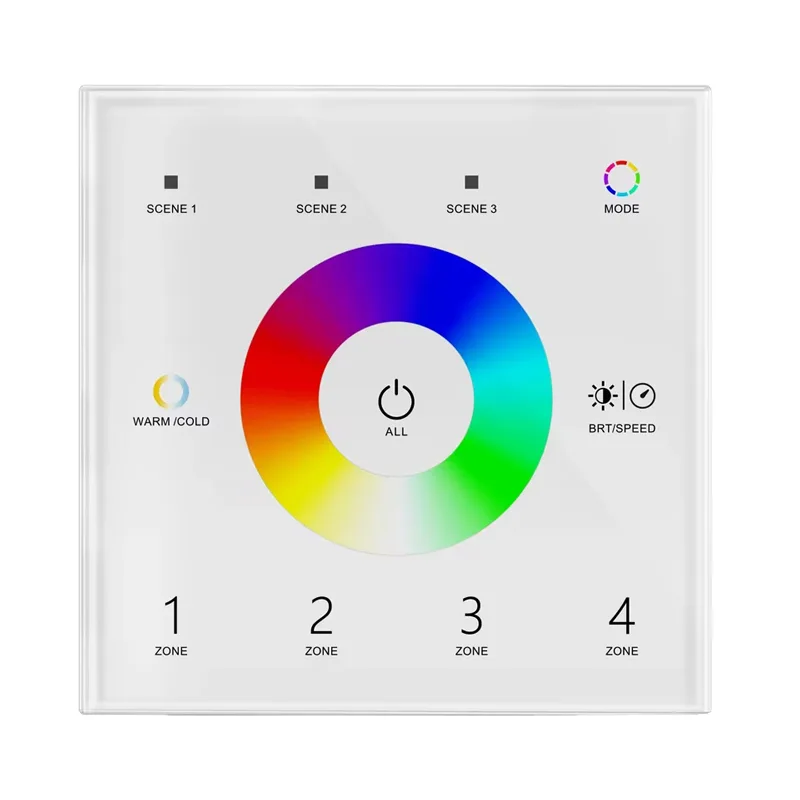
T15壁掛けDMX512タッチパネル
タッチパネル4ゾーン1~5色DMX512マスターは、4ゾーン1~5色RFリモートとしても使用できます。
標準DMX512プロトコルに準拠したDMX信号出力。
RFリモートとして使用する場合、各ゾーンは複数のRF 2.4G LEDコントローラ、調光ドライバ、またはスマートランプをリモート制御できます。
超高感度、高強度。
T15壁掛けDMX512タッチパネルのデータシートをダウンロードする
価格:24.98米ドル/個
2.DMX512コントロールr:DMX512コントローラーは、舞台照明や建築照明の特殊効果装置を集中的に調整・制御するための中核装置。DMX512プロトコルに基づいたデジタル信号で指示を伝達します。複数の装置(ランプやモーターなど)を同時に管理し、明るさ、色、動的効果などのパラメーターを正確に調整し、独立したアドレスで各装置に対応するチャンネルデータを識別できます。プリセットシーンのプログラミングやリアルタイム制御をサポートし、光の変化の同期化と自動化を実現します。
K-1000CとK-8000Cはオフライン制御に適しています。1台で使用することも、より多くのLEDピクセルを駆動するために複数のカスケードで使用することもできます。
a.メインランプが80,000ピクセル以下の場合、K-1000C DMXピクセルコントローラーを使用することをお勧めします。
b.メインランプが8,000~20,000ピクセルの場合は、DMX LEDピクセルコントローラーK-8000Cの使用を推奨します。

II.DMX-SPIデコーダー
DMX512信号をLEDライトストリップが認識できるプロトコル(SPIなど)に変換する。例えば、TM1803やUCS512などのチップが使用され、各チップは1つ以上のLEDピクセルのRGBチャンネル制御に対応する。
各LEDピクセルには独立したアドレスコードを割り当てる必要があり、ポイントごとの制御はチャンネルマッピングによって実現される(例えば、RGBピクセルは3つのDMXチャンネルを占有する)。
DMXコンソールで制御でき、複数のDMXデコーダーを接続して出力パワーを高め、すべての機能を実現できます。様々なモード変更さらに、DMXデコーダーはシンクロナイザーとしても使用できます。コントローラーが個別にLEDを制御し、シンクロ効果を実現します。
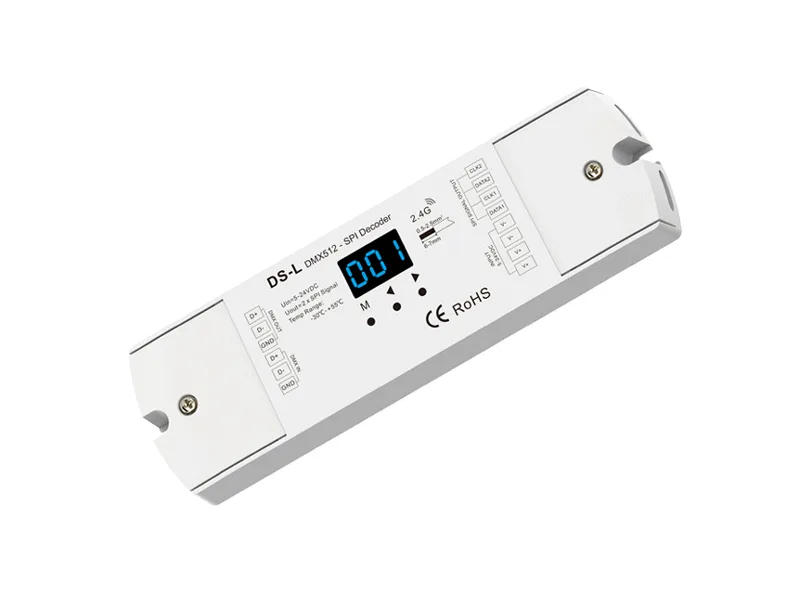
DMX to SPI RGB RGBWデコーダーおよびRFコントローラー
モデルCTL-RGB-DMX-DS-L
電源電圧DC5V~24V
消費電力1W
入力信号DMX512 + RF 2.4GHz
出力信号SPI(TTL)×3/4チャンネル
ダイナミック・モード:32
コントロールドット:170ピクセル(RGB 510CH)、最大900ピクセル
寸法L175×W54×H27mm
CTL-RGB-DMX-DS-Lのデータシートをダウンロードする
価格:16.98米ドル/個
III. 防水LEDネオンストリップ用DMX信号アンプDA
DMX信号の伝送距離を延長するために使用され、1入力、複数出力をサポートします。光電絶縁技術により信号の安定性を高め、長距離や複雑な電磁環境に適しています。
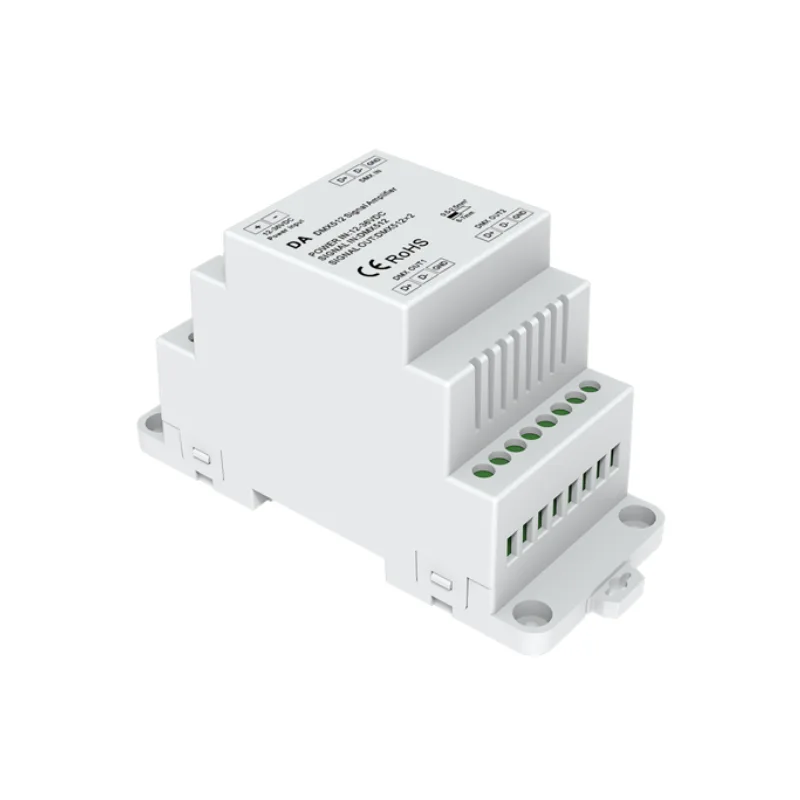
DA DMX信号アンプ
2チャンネルDMX 512信号アンプ。
1つのDMX512信号入力、2つのDMX512信号出力。DMX照明システム機器がDMX512(またはRS-485)のバスに接続されたとき、DMX照明システム機器から来る信号を増幅、分配、絶縁する専用品です。
信号伝送距離の延長を実現。
DMX(485)信号増幅器を増設し、多チャンネル制御を分配。
価格:24.98米ドル/個
電源の設定方法は?
DMX512 LEDネオンストリップシステムは通常、複数のライトセグメントで構成され、総負荷電力と動的変化に応じてマージンを確保する必要があります。
1.総負荷電力計算:P合計=∑(単光部パワー×数)
単一のライトセクション力:メートルまたはセクションごとの DMX512 LED のネオン ストリップ力(5 W/m のような)。
例ライトテープが10本あり、1本が3メートル、1メートルあたりの電力は8W。合計 = 10 × 3 × 8 = 240 W
2.電源の定格電力計算電力=P合計×(1+安全率)÷電力効率+P(DMXコントローラー)
安全係数:0.2~0.3(DMXシステムは頻繁な調光と電流変動があります)を取ることをお勧めします。
電力効率:通常85%~95%(スイッチング電源の方が効率的)。
DMXコントローラーの消費電力:通常5~20W(特定のモデルを参照する必要があります)。
例
総負荷240W、安全係数0.3、電源効率90%、コントローラー消費電力15W:
電源=240X1.3÷0.9+15≒303+15=362W
360W以上の電源を選択すること。
ブランド電源 (信号干渉や電圧降下の問題を最小限に抑えるため、Mean Well XLG シリーズなど)の使用を推奨します。ライトバーの電力(例:12W/m@RGB)に合わせて安定した電圧(通常DC12Vまたは24V)を供給する。
電圧降下とは?
端的に言えば、だ、 電圧降下 は、電流がLED照明器具を通過する際に、回路内の電圧が流れる際に発生するエネルギー損失である。このプロセスは、細いパイプを流れる水の流れに似ており、水の速度は摩擦によって一定のエネルギー損失を生じる。LEDランプやランタンの場合、電圧降下は出力不足につながり、ランプやランタンの発光効率や寿命に影響を与えます。
LEDストリップの電圧降下問題とは、LEDストリップを電源に接続する際、回路の長さや電圧降下がもたらす微小電流のために、LEDストリップの明るさが十分でなくなったり、ムラが生じたりすることである。この問題は、LEDライトストリップを長期間使用しているユーザーにとっては非常に厄介であり、解決策を模索しなければならない!
LEDストリップの電圧降下の原因:
- 小さい電流LEDストリップライトの電流は通常0.02~0.03Aと小さいため、短いラインでも電圧損失が発生し、長いラインではより顕著になります。
- 行の長さ:一般的に言って、ドライバーとLEDストリップライトの間のライン長が長ければ長いほど、電圧降下の問題は顕著になる。
- 品質問題:LEDストリップの品質も電圧降下の問題に影響することがある。低品質のLEDストリップの中には、内部抵抗の過不足が原因で電圧降下の問題が発生し、ライン抵抗を増加させるものがある。
LEDネオン・ストリップ設置用ワイヤーの選び方
DMX512システムの低電圧電源(12V/24V DC)は、ライン電流が大きく、電圧降下の問題が特に顕著で、末端電圧が安定していることを確認する必要があります。
ランプビーズの前後で発光輝度の一貫性を確保し、ライトストリップの電圧降下の影響を避けるため、通常、以下の方法を使用することができます:
線径を太くする:線間抵抗を下げる(一般的な線径:1.5mm²、2.5mm²)。
電源の分割:長距離配線の場合は、電源を複数の回路に分割する。
電源電圧のアップグレード:末端の電圧降下が大きすぎる場合は、少し高い電圧の電源を使用する(例えば、12Vの代わりに24Vのシステムを設計する)。
電圧降下に正しく対処するだけでなく、導体に頼らずに線径を大きくするには、コスト増と配線の合理性を考慮する必要があります。私たちは、電圧降下の問題をさらに補うために、次のステップを正しく選択することができます。
ステップ1.タップ電流を計算する
DMXシステムは通常複数の制御回路に分かれており、負荷回路ごとに個別に計算する必要がある:
Iシングル=Pシングル/Vワーク
例:ストリップ3分割の単一負荷(3m×8W/m×3分割=72W)、動作電圧は24V。
I単一回路 = 72/24 = 3.0A
ステップ2:電圧降下の計算
R=ρ×(2L/A)
ΔU=I単回路×Rライン
主なパラメーター
ρ:銅線の抵抗率を0.0172Ω・mm²/mとする。
L:電源からエンドまでの片道距離(単位:メートル)。
A:ワイヤーの断面積(単位:mm²)。
2L:現在の往復経路の全長は2Lである。
例
単回路電流3A、線路一方向の長さ15m、1.5mm²の銅線を使用:
R = 0.0172 x (2 x 15/1.5) = 0.344Ω
電圧降下:ΔU=3AX0.344Ω≒1.032VV
終止電圧:24V-1.032V=22.97V(4.29%の電圧降下、≦5%の要求に沿う)。
許容電圧降下:通常、動作電圧の5%~10%を超えないことが要求される(12V系電圧降下≦0.6~1.2V、24V系≦1.2~2.4V)。
注意事項
1.信号と電源の分離:独立した電源を取ることをお勧めします。DMXコントローラーとLEDライトストリップは、干渉を避けるために独立した電源を使用することをお勧めします。
2.シールド線:DMX信号線はツイストシールド線(例:CAT5e)を使用し、電源線から30cm以上離してください。
3.分割電源戦略:長距離に設置する場合は、単一回路の電圧降下を抑えるため、20~30メートルごとに電源ポイントを設置する。
4.電源の同期:複数の電源が並列に接続されている場合、電位差がDMX信号に干渉するのを避けるため、共通のグラウンドを確保するか、同期モジュールを使用してください。
5.終止電圧の測定:マルチメータを使用し、終止電圧が定格電圧の≧90%であることを確認する。
6.信号安定性テスト:電源干渉によりDMX信号がちらついたり、パケットを失ったりしないかチェックする。
7.温度上昇試験:1時間の全負荷運転後、電源の表面温度は≤60℃でなければならない。
屋外への設置については、ポストを参照してください: 建築家とインストーラー向け屋外LEDネオンフレックス・マウントソリューション.
まとめ
DMX制御 LED Nイーオンフレックス は、標準化されたプロトコルと高い干渉防止機能により、建築照明プロジェクトに理想的な選択肢となっている。
この技術はDMX512プロトコルで精密な照明制御を実現し、長距離信号伝送(最大数百メートル)とマルチノード同期をサポートし、明るさ、色、動的効果を柔軟に調整することができ、建物のファサード装飾、景観照明などのシーンに適しています。
差動信号伝送技術を採用し、電磁干渉を効果的に回避し、ブレークポイント伝送機能をサポートし、システムの安定性を高める。例えば、DMX512アドレスエディターを使ってランプとランタンのアドレスを設定し、コントローラー(例えば、Interact IoTプラットフォーム)を通じて、集中管理を実現し、エネルギー消費とメンテナンス効率を最適化する。
インテリジェント調光とゾーニング制御を組み合わせることで、DMX512 LEDネオンライトシステムは、長期的な信頼性の高い動作を確保しながら、合理的な設計により、正確な制御と均一な明るさを実現することができます。
